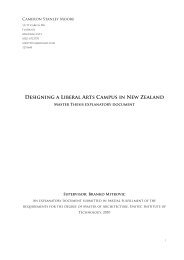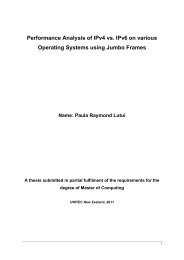The Study of Students Perceptions of On-campus ... - Research Bank
The Study of Students Perceptions of On-campus ... - Research Bank
The Study of Students Perceptions of On-campus ... - Research Bank
You also want an ePaper? Increase the reach of your titles
YUMPU automatically turns print PDFs into web optimized ePapers that Google loves.
institute owns multi buildings. For different types <strong>of</strong> organisation, the<br />
benefits to people are different. In education, students and teachers are<br />
benefit from easier access to information. This can be compared with the<br />
people in IT departments who are benefit from “easier infrastructure<br />
implementation in the reduction <strong>of</strong> physical cabling required”<br />
(“Government Solution Blueprint”, 2003).<br />
“Laptop has become must-have for today's college students” by Brass (2004)<br />
stated that the demand for laptops by college students was rising to a top<br />
position on the supply lists for schools. <strong>The</strong> report mentioned that “in the<br />
past couple <strong>of</strong> years almost 100 percent <strong>of</strong> dorm students have activated<br />
their network connections and increasing numbers are lugging laptops to<br />
class” (Brass, 2004). As soon as wireless happened laptop sales increased.<br />
<strong>Students</strong> not only took laptops but also took personal digital assistants or<br />
PDAs to school. According to Brass (2004), students took laptops to school<br />
for academic uses and other capabilities <strong>of</strong> the wireless network, such as<br />
keeping in touch with friends and family through instant messaging<br />
services. <strong>The</strong> report stated that a first year student would spend $759.97<br />
on electronics out <strong>of</strong> $1,200 on school gear. According to Brass (2004), “the<br />
organization estimated that, in all, parents and students would spend $7.5<br />
billion on electronics compared to $3.2 billion on clothing and accessories,<br />
$2.6 billion on dorm or apartment furnishings, $2.1 billion on school<br />
supplies and $1.5 billion on shoes.” <strong>The</strong> author considered that computers<br />
were expensive and computer purchases increased the students’ budget. If<br />
schools required students have to have a computer, they could pay for it by<br />
using federal loans. <strong>The</strong> school might require students to have computers<br />
because <strong>of</strong> the needs <strong>of</strong> some courses, such as architecture and design,<br />
engineering and business. For example, “business students have used the<br />
computers to set up simulated business” (Brass, 2004).<br />
10











